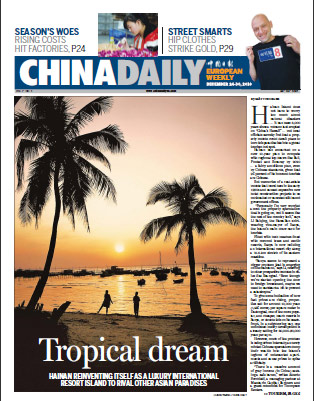Nokia joins slimming trend
Updated: 2006-11-28 14:08
By CASSELL BRYAN-LOW (WSJ)
Nokia Corp.'s new design chief, Alastair Curtis, will be under the spotlight today as the company makes a presentation to shareholders who are looking for signs of improvement in the handsets offered by the world's largest maker of cellphones.
In particular, investors want to know if Nokia plans to add thin handsets to its portfolio of products in the face of competition from Motorola Inc., which pioneered the category with its slim RAZR model, and Samsung Electronics Co. "The world is waiting for Nokia's first slim phone," says Thomas Langer, a research analyst at WestLB AG.
Missing out on the thin trend is the latest design flub for Espoo, Finland-based Nokia, which in recent years has been late with other key developments in the industry, including clamshell-shaped phones and sharp color screens.
Overall, Nokia's handsets tend to be more clunky and less attractive than those of its key competitors, analysts say. "Designs in the last 12 months have been pretty disappointing," says Richard Windsor, an analyst at Nomura Securities. "[It] remains an area where they need to shape up." Both Mr. Windsor and WestLB's Mr. Langer are among those who plan to attend Nokia's annual capital-markets day today in Amsterdam.
Nokia executives acknowledge that the company needs to focus on design. "Thinness is clearly important," says Mr. Curtis, adding that Nokia already has introduced thinner phones and plans to unveil more over the coming months. He declined to discuss any specific product announcements.
Mr. Curtis, a 38-year-old from Britain who became Nokia's head of design in April, has taken over at a difficult time. He must wrestle with packing ever-more features, such as camera lenses and large screens, into phones at the same time that consumers are looking for ever-smaller handsets.
"Nokia doesn't like to compromise technology for vanity," says Ben Wood, an analyst at research firm Collins Consulting Ltd.
Nokia's sales in the third quarter rose 20% from a year earlier to �0.1 billion ($13.23 billion), driven by high-end multimedia phones as well as simpler, low-cost handsets in emerging markets. But Nomura's Mr. Windsor says that by lacking a direct challenger to Motorola's iconic RAZR, Nokia has missed out on its share of a potential $7.5 billion of sales, when taking into account the roughly 50 million RAZRs shipped at an average price of $150 each over the life of the product.
Nokia's American depositary shares were off 62 cents, or 3%, at $20.31 in 4 p.m. composite trading on the New York Stock Exchange. That is up from $17.28 a year ago but off the 52-week high of $23.10.
Another challenge for Mr. Curtis is that in order to defend Nokia's enviable market share -- 35% of the global handset market in the third quarter, according to research firm Gartner Inc. -- the company needs to ensure that it has a vast selection of handsets on offer that not only span a broad range of prices, but also appeal to different consumers.
Meanwhile, Nokia's competitors, including the No. 2 handset maker by sales, Motorola, and No. 3 Samsung, generally cover fewer price and consumer categories, analysts say.
Analysts and cellphone-service providers that are the biggest purchasers of Nokia phones say the company's product range has seen some improvements over the past year or so. In May, the handset maker launched its slimmest model to date, the 15.5-millimeters, or 0.6 inch, thick E50.
Still, Nokia's products typically remain bulkier than those of its competitors. Motorola recently announced the nine-millimeter MotoFone, due to launch early next year. And Samsung in August launched a 6.9-millimeter phone, the X820.
But thinness is relative, argues Mr. Curtis, because a phone's features also are important. He points to Nokia's N93, a 28.2 millimeter-thick handset that also functions as a camcorder, has a hearty 50 megabytes of internal memory and a large, flip-up screen for watching television.
Still, some analysts believe Nokia is overemphasizing function over form. "I think they're completely missing the point," Nomura's Mr. Windsor says of Nokia. "People are still using phones predominantly for text and voice," rather than utilizing the extra functions Nokia is putting into devices like television and video.
Mr. Curtis, who joined Nokia in 1993 as an industrial designer and has held several senior design positions, says he is making a number of changes to revamp the design organization. Those include hiring more staff, moving the Helsinki-based design team to the corporate headquarters to be closer to senior management as well as putting designers in outposts such as Rio de Janeiro, Brazil, and Bangalore, India.
He says it's too early to point to tangible results in terms of a specific product -- which can take two years or more to reach the market -- but claims there is an improvement in the team's creativity and morale.
Among other areas of focus for the design team is the development of the mobile Internet, says Mr. Curtis, which for many people in emerging markets will be how they first explore the Web. "We believe there are other things beyond thin that will also have an impact on the [cellphone] market," he says.
Paper's Digest

Jingle bells
The younger generation and every king of retailer are embracing the christmas holiday more than ever before across China.
Chinese shoppers boost luxury market
Growing appetite for foreign firms
Happiness quotient
Specials

If you're happy and you know it
Chinese J.K. Rowling's best-selling children's works are rapidly finding a foreign audience

Clothes maketh this man
English entrepreneur pioneers hip streetwear culture and becomes one of the locals in old Beijing.

Ich bin ein Beijinger
German sinologist's lifelong connection with China is deeply rooted.
